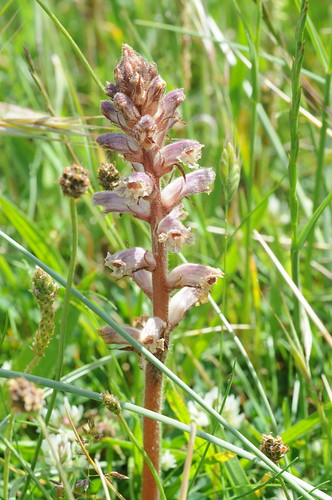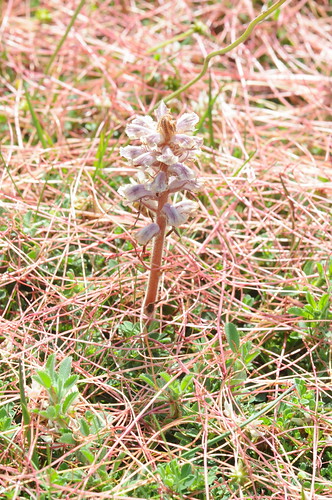Don't worry - this post isn't gonna get all gross and tapewormy (not that tapeworms aren't absolutely fascinating - really!). I'm talking about parasitic plants. A few weeks ago, admiring the riot of colour in the orchid fields I decided this was the year to really make an effort and track down at least 2 of the 4 orchids I've yet to see on the island (1 of the 4 is tiny and ephemeral and another has a population of 1 so 2 of 4 is a "realistic" if easy looking goal). Suffice it to say more orchid photos are to come.
As always however in the world of nature, looking for one thing leads to another, distractions creep in and before you know it you're googling for data about something you've never heard of. In short I got kind of intrigued by a number of our other wildflowers and their attendant insects.
This is Common Broomrape, Orobanche minor, which is a parasite of various species in the pea and daisy families. Interestingly (and about which more momentarily), wiki tells us that "the species has efficient seed dispersal and is largely inbreeding so that populations preferentially parasitizing a particular species which has its own clear ecological preferences and may become effectively isolated and eventually may produce distinct taxa."
Apparently broomrapes penetrate thier hosts with something called a haustorium (basically a modified root) which sucks nutrients from it. They are completely non-photosynthetic (hence the flower but no leaves). The common broomrape is just one of two parasites in the picture below however....
The other parasite is Dodder, Cuscuta europaea, a parasitic member of the morning glory family. Dodder binds itself around other plants in a similar member to normal bindweeds or morning glories. The difference being once it's bound on it slams haustoria into the other plant and starts to use it for nutrients. As I understand it the roots often die off completely and the plant subsists entirely above ground leaching off it's hosts. It'll latch onto pretty much anything.
Movng back to broomrapes, remember that bit about them eventually speciating into host specific species? This is ivy broomrape. It feeds on (you've guessed it) ivy and ivy alone...
Ivy broomrape, Orobanche hederae



No comments:
Post a Comment